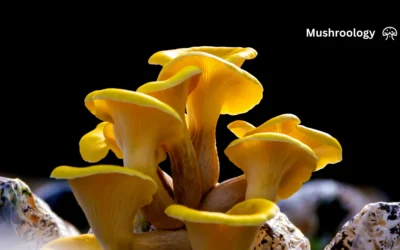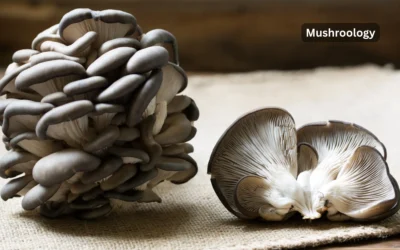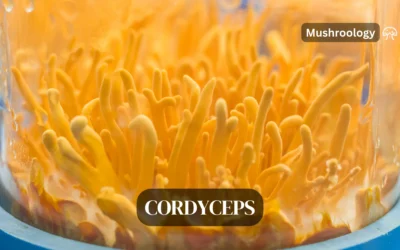Mushroom tinctures have surged in popularity as more people discover the concentrated wellness benefits of medicinal fungi. These liquid extracts offer a potent way to access the health-supporting compounds found in mushrooms like reishi, lion’s mane, and chaga. In fact, the global mushroom market is projected to reach $78.7 billion in 2025, with medicinal mushroom products leading this growth at 9.5% annually.
What are mushroom tinctures?
A mushroom tincture is a concentrated liquid extract made by soaking mushroom parts in a solvent—typically alcohol, water, or a combination of both. This process draws out the mushrooms’ bioactive compounds, creating a potent solution that’s easy to consume and absorb.
Tinctures are highly concentrated, allowing you to receive the benefits of medicinal mushrooms in just a few drops. They’re typically dark in color and have a distinct earthy flavor that varies depending on the mushroom species used.
Why choose mushroom tinctures over powders or capsules?
Mushroom tinctures differ from other mushroom products in several key ways:
- Powders are dried and ground mushrooms that contain the whole fruiting body. While convenient, they may have lower bioavailability than tinctures.
- Capsules contain mushroom powder in a convenient pill form but may take longer to digest and absorb.
- Teas are water extractions that capture water-soluble compounds but miss those that are only alcohol-soluble.
- Tinctures extract both water-soluble and alcohol-soluble compounds, making them more comprehensive. They also have excellent absorption rates since they’re already in liquid form.
According to a 2021 study published in the Journal of Fungi, liquid extracts like tinctures showed 30% higher bioavailability of certain mushroom compounds compared to powder forms.
Mushroom tinctures stand out from other supplements because:
- Better absorption: Liquid form means your body absorbs beneficial compounds faster.
- Convenience: Easy to dose and carry anywhere.
- Comprehensive extraction: Tinctures extract both water-soluble and alcohol-soluble compounds, capturing the full spectrum of benefits.
How tinctures work in your body
When you consume a mushroom tincture, the extracted compounds enter your bloodstream quickly—often within 15-30 minutes. Because the active ingredients are already extracted and suspended in liquid, your digestive system doesn’t need to break down fibrous mushroom material.
The alcohol in many tinctures also helps preserve the compounds and enhances absorption through the mucous membranes in your mouth when held under your tongue (sublingual administration).
Key compounds in mushroom tinctures
Medicinal mushrooms contain several important bioactive compounds that contribute to their health benefits. Here’s what you’ll find in most mushroom tinctures:
Beta-Glucans
Beta-glucans are complex polysaccharides found in the cell walls of many mushrooms. These compounds are perhaps the most studied of all mushroom components due to their impressive immune-modulating properties.
Research published in the International Journal of Medicinal Mushrooms shows that beta-glucans can:
- Enhance the activity of natural killer cells and macrophages
- Help regulate immune response
- Support the body’s defense against pathogens
Beta-glucans are water-soluble, which is why hot water extraction is an important part of making effective mushroom tinctures.
Terpenoids
Terpenoids are a diverse group of compounds that give many mushrooms their distinctive smell and flavor. More importantly, they contribute significantly to medicinal effects.
These compounds are primarily alcohol-soluble, which is why alcohol extraction is crucial for a complete tincture. Terpenoids found in medicinal mushrooms have demonstrated:
- Anti-inflammatory properties
- Neuroprotective effects
- Antioxidant capabilities
Phenolic compounds
Phenolic compounds act as powerful antioxidants, helping to neutralize harmful free radicals in the body. A 2019 analysis in Food Chemistry found that many medicinal mushrooms contain high concentrations of phenolic compounds, with extraction methods significantly affecting their availability.
These compounds can help:
- Combat oxidative stress
- Support cellular health
- Promote longevity
Other beneficial molecules
Depending on the mushroom species, tinctures may also contain:
- Triterpenes: Found abundantly in reishi mushrooms, these compounds have adaptogenic properties.
- Hericenones and erinacines: Present in lion’s mane mushroom and known for their potential to support brain health.
- Cordycepin: A unique compound in cordyceps that has been studied for its energy-supporting properties.
Benefits of mushroom tinctures
1. Enhanced bioavailability
One of the primary advantages of tinctures is improved bioavailability—the rate and extent to which active compounds enter your bloodstream. The extraction process breaks down the mushroom’s chitin cell walls (which humans cannot digest easily), making the beneficial compounds more accessible.
A comparative study in the Journal of Ethnopharmacology found that liquid extracts delivered up to 60% higher concentrations of certain mushroom compounds in the bloodstream compared to consuming the same amount of dried mushroom.
2. Longer shelf life and convenience
Mushroom tinctures typically last 2-5 years when stored properly, significantly longer than fresh or dried mushrooms. The alcohol content acts as a natural preservative, preventing bacterial growth and oxidation.
Taking tinctures is also remarkably convenient:
- No preparation time (unlike cooking with mushrooms or making tea)
- Easy to transport in small bottles
- Precise dosing with dropper caps
- Can be added to beverages or taken directly
3. Customizable potency and combinations
When making tinctures at home, you can adjust the concentration by using more mushroom material or extending the extraction time. This allows you to create products tailored to your specific needs.
You can also create custom blends by combining different mushroom tinctures. For example:
- Lion’s mane and reishi for cognitive support and stress management
- Chaga and turkey tail for immune function
- Cordyceps and maitake for energy and metabolic health
4. Cost-effectiveness vs. commercial options
While high-quality commercial mushroom tinctures can cost between $30-$70 per ounce, making your own can reduce this cost by 50-70%. A homemade dual-extraction tincture using $20 worth of dried mushrooms can yield approximately 16 ounces of product—equivalent to over $200 worth of commercial tinctures.
Who should consider using mushroom tinctures
Mushroom tinctures can be particularly beneficial for:
- Busy professionals seeking cognitive support or stress management
- Athletes looking for recovery and performance benefits
- Wellness enthusiasts interested in preventative health approaches
- Those with immune concerns seeking natural support options
- People who dislike the taste or texture of whole mushrooms
Potential contraindications and precautions of mushroom tinctures
While mushroom tinctures are generally considered safe for most people, certain individuals should exercise caution:
- Those taking blood-thinning medications: Some mushrooms like reishi may have mild anticoagulant effects.
- People with alcohol sensitivities: Alcohol-based tinctures may not be appropriate.
- Individuals with mushroom allergies: Even extracted products may trigger allergic reactions.
- Pregnant or nursing women: Limited research exists on the safety of concentrated mushroom extracts during these periods.
According to a 2022 review in Frontiers in Pharmacology, most adverse reactions from mushroom supplements are mild and rare, but it’s always best to proceed with caution when trying new supplements.
When to consult healthcare providers
Always speak with a healthcare professional before starting mushroom tinctures if you:
- Have a pre-existing medical condition
- Take prescription medications
- Are planning surgical procedures (some mushrooms may affect blood clotting)
- Experience any unexpected symptoms after starting tinctures
A healthcare provider can help determine appropriate dosages and monitor for potential interactions with medications or health conditions.
Getting started with mushroom rinctures
To get started with mushroom tinctures, you’ll need:
Basic equipment:
- Glass mason jars (amber or cobalt blue preferred to protect from light)
- Fine mesh strainer
- Cheesecloth or coffee filters
- Amber glass dropper bottles for storage
- Funnel (preferably glass or stainless steel)
- Label materials
Ingredients:
- Dried medicinal mushrooms (organic and properly identified)
- High-proof alcohol (vodka, brandy, or food-grade ethanol, 80-100 proof)
- Filtered water
Choose quality mushrooms
The quality of your mushrooms directly impacts the quality of your tincture. Look for:
- Organic certification to avoid pesticide residues
- Whole mushroom products rather than mycelium grown on grain
- Proper identification from reputable suppliers
- Certificate of analysis showing beta-glucan content and testing for contaminants
Wild-harvested mushrooms should only be used if you’re confident in your identification skills or have had them verified by an expert mycologist.
Brief overview of extraction methods
There are three main methods for creating mushroom tinctures:
- Alcohol extraction: Captures alcohol-soluble compounds like triterpenes and some phenolics.
- Hot water extraction: Extracts water-soluble compounds like beta-glucans and polysaccharides.
- Dual extraction: Combines both methods for the most complete extraction of beneficial compounds.
For most medicinal mushrooms, dual extraction is recommended to capture the full spectrum of beneficial compounds. This process typically involves first extracting with alcohol, then performing a hot water extraction, and finally combining the two liquids.
To maintain potency and extend shelf life:
- Store tinctures in amber or blue glass bottles to protect from light
- Keep in a cool, dark place like a cabinet or pantry
- Avoid exposure to heat or direct sunlight
- Ensure droppers don’t touch your mouth to prevent contamination
- Label bottles with contents and date of production
Properly stored mushroom tinctures can remain potent for 2-5 years, though they’re typically most potent in the first 2 years.
Final thoughts
Mushroom tinctures offer a convenient, effective way to incorporate the benefits of medicinal mushrooms into your daily routine. With higher bioavailability, longer shelf life, and customizable options, they represent an accessible entry point into the world of functional fungi.
Whether you’re interested in immune support, cognitive enhancement, stress management, or overall wellness, mushroom tinctures provide a concentrated form of nature’s pharmacy. By understanding the fundamentals covered in this guide, you’re now equipped to make informed decisions about incorporating mushroom tinctures into your health regimen.
In our next article, we’ll dive deeper into the step-by-step process of making your own mushroom tinctures at home, including detailed instructions for each extraction method and tips for creating the most potent formulations.
Ready to experience the benefits of mushroom tinctures for yourself? Start by researching quality suppliers of medicinal mushrooms or look for reputable commercial tinctures to try before making your own.
Frequently Asked Questions
How quickly do mushroom tinctures work?
Some effects, like improved energy or focus, may be noticeable within 30-60 minutes of consumption. Other benefits, particularly immune and adaptogenic effects, typically develop with consistent use over 2-4 weeks.
How much mushroom tincture should beginners take?
Most experts recommend starting with 1-2 droppers (approximately 1-2 ml) once or twice daily. Begin with smaller amounts and gradually increase to assess your individual response.
Can I take different mushroom tinctures together?
Yes, different mushroom tinctures can be combined for complementary effects. Many users create morning and evening blends tailored to their specific health goals.
Are alcohol-free mushroom tinctures effective?
Glycerin-based or apple cider vinegar tinctures can be alternatives to alcohol, though they may not extract all compounds as effectively. Water extracts (decoctions) are another alcohol-free option but may have shorter shelf lives.
What’s the difference between a mushroom tincture and extract?
All tinctures are extracts, but not all extracts are tinctures. Tinctures specifically use alcohol as at least one of the solvents, while extracts can use various solvents like water, vinegar, or glycerin.





